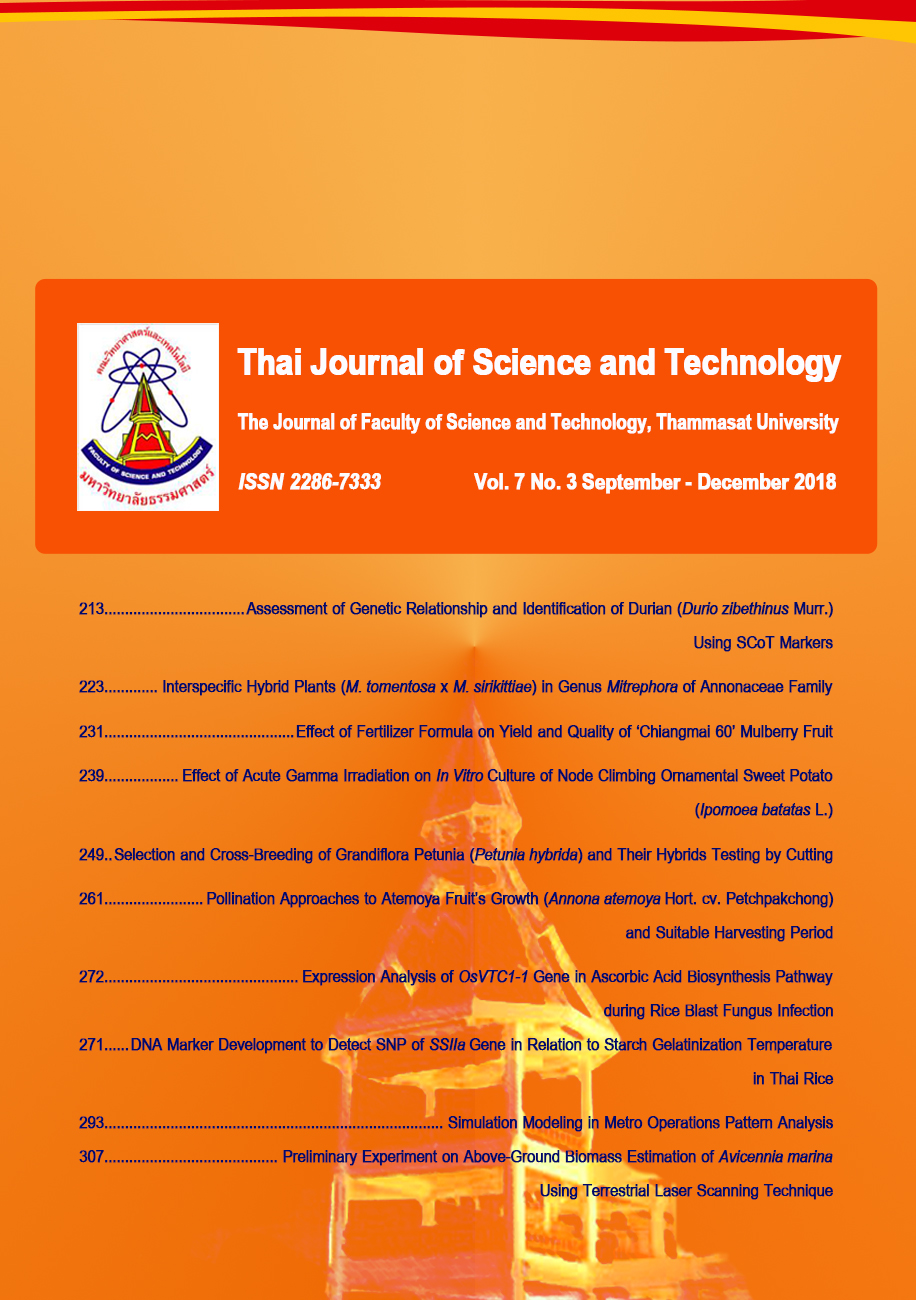Expression Analysis of OsVTC1-1 Gene in Ascorbic Acid Biosynthesis Pathway during Rice Blast Fungus Infection
Main Article Content
Abstract
Abstract
Rice (Oryza sativa) is an important staple food crop in the world especially in Asia. Nowadays, the rice yields in Thailand have lower productivity due to many factors such as fungal diseases. Magnaporthe oryzae also known as a rice blast fungus, is an important plant pathogen that causes lesions in all parts of the plant. Ascorbic acid (AsA) or vitamin C is a powerful antioxidant and plays an important role in the plant defensive response. Previous study showed that GDP-D-mannose pyrophosphorylase (GMP or VTC1) is a key gene in ascorbic acid synthesis pathway. In this experiment, we aim to study the expression level of OsVTC1-1 gene during rice blast fungus infection. Two isolates of rice blast fungus that can and cannot infect Jao Hom Nin were used. Leave samples were collected at 0, 6, 12, 24 and 36 hours after inoculation. Then, the expression level of OsVTC1-1 gene was examined using semi-quantitative RT-PCR. The results showed that OsVTC1-1 gene was expressed at the highest level at 12 hours after inoculation and decreased to normal levels after 12 hours. The pattern of this gene expression showed the same in both resistance and susceptible reaction, which indicated that AsA may play a role in defense response upon fungal infection. OsVTC1-1 gene was cloned to study gene structure and genetic relationship among plant species. This gene consists of 1,086 bp and encodes 362 amino acid residues. The phylogenetic tree revealed that OsVTC1-1 was grouped into two groups, monocotyledon and dicotyledon. Our results suggested that OsVTC1-1 is conserved throughout plant kingdom and may play an important role in rice blast fungus defense response.
Keywords: ascorbic acid; blast disease; L-galactose pathway; rice; vitamin C
Article Details
บทความที่ได้รับการตีพิมพ์เป็นลิขสิทธิ์ของคณะวิทยาศาสตร์และเทคโนโลยี มหาวิทยาลัยธรรมศาสตร์ ข้อความที่ปรากฏในแต่ละเรื่องของวารสารเล่มนี้เป็นเพียงความเห็นส่วนตัวของผู้เขียน ไม่มีความเกี่ยวข้องกับคณะวิทยาศาสตร์และเทคโนโลยี หรือคณาจารย์ท่านอื่นในมหาวิทยาลัยธรรมศาสตร์ ผู้เขียนต้องยืนยันว่าความรับผิดชอบต่อทุกข้อความที่นำเสนอไว้ในบทความของตน หากมีข้อผิดพลาดหรือความไม่ถูกต้องใด ๆ
References
Herdt, R.W., 1991, Research priorities for rice biotechnology, In Khush, G.S., Toenniessen, G.H. (Eds.). Rice Biotechnology. Alden Press, Ltd., London, 35-37.
Imai, T., Ban, Y., Yamamoto, T. and Moriguchi, T., 2012, Ectopic overexpression of peach GDP-D-mannose pyrophosphorylase and GDP-D-mannose-3, 5 epimerase in transgenic tobacco, Plant Cell Tiss Organ Cult. 111: 1-13.
Jo, Y.K., Wang, G.L. and Boehm, M.J., 2007, Expression analysis of rice defense-related genes in turfgrass in response to Magnaporthe grisea, Phytopathology 97: 170-178.
Kiddle, G., Pastori, G.M., Bernard, S., Pignocchi, C., Antoniw, J., Verrier, P.J. and Foyer, C.H., 2003, Effects of leaf ascorbate content on defense and photosynthesis gene expression in Arabidopsis thaliana, Antioxid. Redox Signal. 5: 23-32.
Miedes, E., Vanholme, R., Boerjan, W. and Molina, A., 2014, The role of the secondary cell wall in plant resistance to pathogens, Front. Plant Sci. 5: 1-13.
Nanda, A.K., Andrio, E., Marino, D., Pauly, N. and Dunand, C., 2010, Reactive oxygen species during plant-microorganism early interactions, J. Integr. Plant Biol. 52: 195-204.
Ohyanagi, H., Ebata, T., Huang, X., Gong, H., Fujita, M., Mochizuki, T., Toyoda, A., Fujiyama, A., Kaminuma, E., Nakamura, Y., Feng, Q., Wang, Z.X., Han, B. and Kurata, N., 2016, Oryzagenome: genome diversity database of wild Oryza species, Plant Cell Physiol. 57: 1-7.
Pavet, V., Olmos, E., Kiddle, G., Mowla, S., Kumar, S., Antoniw, J., Alvarez, M.E. and Foyer, C.H., 2005, Ascorbic acid deficiency activates cell death and disease resistance responses in Arabidopsis, Plant Physiol. 139: 1291-1303.
Prasertsri, P., 2017, Grain and Feed Annual, In USDA gain Report.
Qin, H., Deng, Z., Zhang, C., Wang, Y., Wang, J., Liu, H., Zhang, Z., Huang, R. and Zhang, Z., 2016, Rice GDP-mannose pyrophosphorylase OsVTC1-1 and OsVTC1-3 play different roles in ascorbic acid synthesis, Plant Mol. Biol. 90: 317-327.
Rajput, L.S., Sharma, T., Madhusudhan, P. and Sinha, P., 2017, Effect of temperature on rice blast infection process with emphasis on appressoria formation by Magnaporthe oryzae, Int. J. Curr. Microbiol. App. Sci. 6:
1931-1939.
Simpson, M.G., 2010, Plant Systematics. 2nd Ed., Elsevier Academic Press, China.
Sreewongchai, T., Sriprakhon, S., Wongsaprom, C., Vanavichit, A., Toojinda, T., Tharreau, D. and Sirithunya, P., 2009, Genetic mapping of Magnaporthe grisea avirulence gene corresponding to leaf and panicle blast resistant QTLs in Jao Hom Nin rice cultivar, Phytopathology 157: 338-343.
Tamura, K., Stecher, G., Peterson, D., Filipski, A. and Kumar, S., 2013, Mega6: Molecular Evolutionary Genetics Analysis Version 6.0, Mol. Biol. Evol. 30: 2725-2729.
Titapiwatanakun, B., 2012, The Rice Situation in Thailand, In ADB Technical Assistance Consultant’s Report, 1: 1-29.
Zhang, Y., 2013, Ascorbic acid in plants, Springer-Verlag, New York.


